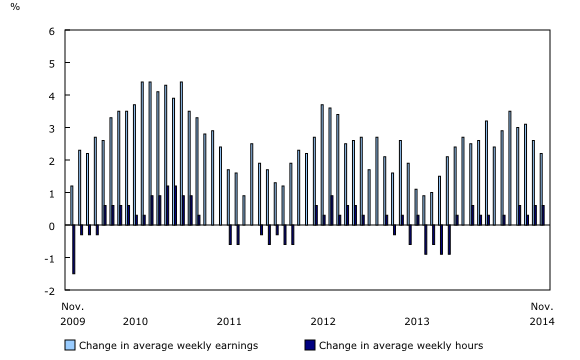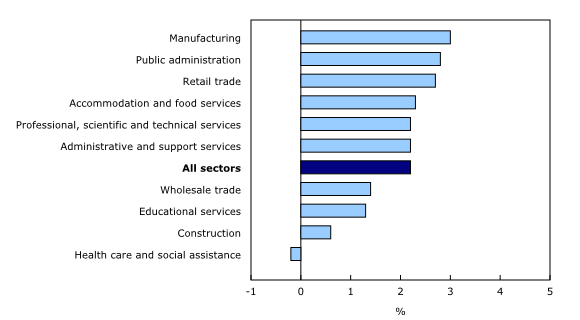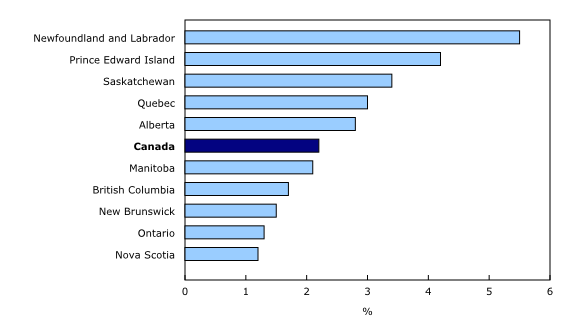Payroll employment, earnings and hours, November 2014
Archived Content
Information identified as archived is provided for reference, research or recordkeeping purposes. It is not subject to the Government of Canada Web Standards and has not been altered or updated since it was archived. Please "contact us" to request a format other than those available.
Released: 2015-01-29
Average weekly earnings of non-farm payroll employees were $941 in November, little changed from $940 the previous month. Compared with 12 months earlier, weekly earnings increased by 2.2%.
The 2.2% increase in weekly earnings during the 12 months to November reflected a number of factors, including wage growth, changes in the composition of employment by industry, occupation and level of job experience, as well as average hours worked per week. Non-farm payroll employees worked an average of 33.0 hours in November, unchanged from the previous month and up from the 32.8 hours in November 2013.
Average weekly earnings by sector
In the 12 months to November, growth in average weekly earnings was at or above the national average of 2.2% in 6 of the 10 largest industrial sectors. Growth was led by manufacturing, public administration and retail trade.
Compared with 12 months earlier, average weekly earnings in manufacturing increased 3.0% to $1,057. Earnings growth was spread throughout this sector, led by gains in the manufacturing of food, transportation equipment, and machinery.
Average weekly earnings in public administration were up 2.8% to $1,207 in the 12 months ending November. Gains in this sector were mainly in provincial and territorial public administration.
Among retail trade employees, average weekly earnings rose 2.7% on a year-over-year basis to $546. Gains in average weekly earnings for this sector were led by motor vehicle and parts dealers.
In the 12 months to November, average weekly earnings were little changed in health care and social assistance, as well as construction, wholesale trade and educational services.
Average weekly earnings by province
Year-over-year average weekly earnings of non-farm payroll employees increased in every province in November. Growth was highest in Newfoundland and Labrador, Prince Edward Island and Saskatchewan, while Ontario and Nova Scotia had the lowest earnings growth.
Average weekly earnings in Newfoundland and Labrador were $1,022 in November, up 5.5% compared with a year earlier. Growth was spread across most sectors in the province, led by transportation and warehousing, health care and social assistance, as well as public administration. At the same time, earnings in educational services declined notably in the province.
In Prince Edward Island, average weekly earnings rose 4.2% to $784, driven by gains in retail trade and manufacturing.
In the 12 months to November, average weekly earnings in Saskatchewan increased 3.4% to $987. Earnings growth was highest in transportation and warehousing; public administration; and health care and social assistance. At the same time, there was a decline in earnings in the construction sector.
Non-farm payroll employment by sector
Total non-farm payroll employment declined by 33,000 in November, after edging up (+9,100) in October. In November, the decrease in the number of employees was spread across most sectors, with the largest declines in retail trade, construction, health care and social assistance, as well as 'other services.'
On a year-over-year basis, non-farm payroll employment increased by 120,400 or 0.8%, with an upward trend from April through October of 2014.
Over the 12 months to November, employment growth was highest in real estate and rental and leasing (+3.9%); mining, quarrying, and oil and gas extraction (+3.8%); construction (+2.7%); and professional, scientific and technical services (+2.7%). At the same time, the largest declines in payroll employment were in information and cultural industries (-3.1%), utilities (-1.5%) and public administration (-1.2%).
Note to readers
With the March 31 release of January 2015 data, the Survey of Employment, Payrolls and Hours (SEPH) will be releasing historically revised estimates. These estimates will include seasonally adjusted data that has been revised based on the latest seasonal factors. Historical revisions will also be made to a number of industries by province and territory, going back to 2001. These revisions will be concentrated in the public sector portion of the economy, particularly public administration.
Note to readers
SEPH is produced by a combination of a census of payroll deductions, provided by the Canada Revenue Agency, and the Business Payrolls Survey, which collects data from a sample of 15,000 establishments. The key objective of SEPH is to provide a monthly portrait of the level of earnings, and the number of jobs and hours worked by detailed industry at the national, provincial and territorial level.
Estimates of average weekly earnings and hours worked are based on a sample and are therefore subject to sampling variability. This analysis focuses on differences between estimates that are statistically significant at the 68% confidence level. Payroll employment estimates are based on a census of administrative data and are not subject to sampling variability.
Statistics Canada also produces employment estimates from its Labour Force Survey (LFS). The LFS is a monthly household survey, the main objective of which is to divide the working-age population into three mutually exclusive groups: the employed (including the self-employed), unemployed and not in the labour force. This survey is the official source for the unemployment rate and collects data on the socio-demographic characteristics of all those in the labour market.
As a result of conceptual and methodological differences, estimates of changes from SEPH and LFS do differ from time to time. However, the trends in the data are quite similar.
Unless otherwise stated, this release presents seasonally adjusted data, which facilitates comparisons by removing the effects of seasonal variations. For more information on seasonal adjustment, see Seasonally adjusted data – Frequently asked questions.
Non-farm payroll employment data are for all hourly and salaried employees, as well as the 'other employees' category, which includes piece-rate and commission-only employees.
Average weekly hours data are for hourly and salaried employees only and exclude businesses that could not be classified to a North American Industry Classification System (NAICS) code.
All earnings data include overtime pay and exclude businesses that could not be classified to a NAICS code. Earnings data are based on gross taxable payroll before source deductions. Average weekly earnings are derived by dividing total weekly earnings by the number of employees.
With each release, data for the current reference month are subject to revision. Data have been revised for the previous month. Users are encouraged to request and use the most up-to-date data for each month.
A Summary table is available from the Browse by key resource module of our website. Under Summary tables, choose Subject then Labour.
Data on payroll employment, earnings and hours for December 2014 will be released on February 26, 2015.
More information about the concepts and use of the Survey of Employment, Payrolls and Hours is available online in The Guide to the Survey of Employment, Payrolls and Hours (Catalogue number72-203-G), from the Browse by key resource module of our website under Publications.
Contact information
For more information, contact us (toll-free 1-800-263-1136; 514-283-8300; infostats@statcan.gc.ca).
To enquire about the concepts, methods or data quality of this release, contact Jeremy Weeks (613-951-1369; jeremy.weeks@statcan.gc.ca), Labour Statistics Division.
- Date modified:




